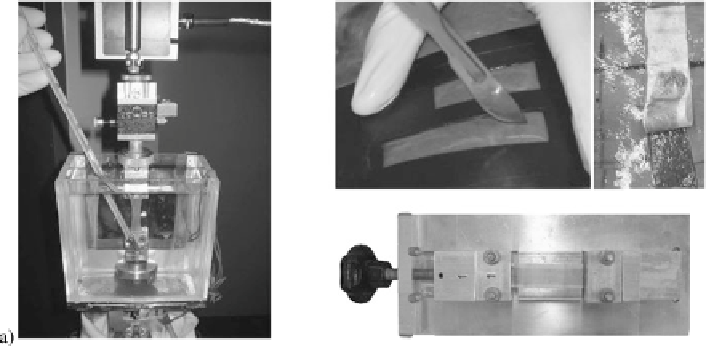Biomedical Engineering Reference
In-Depth Information
Fig. 26.4
Experimental setup and sample preparation for uniaxial tensile testing. (
a
) Situation on
the uniaxial testing machine: the installed sample inside the bio-chamber, the clamping interfaces,
the
xy
-positioning stage, and the load cell are visible. (
b
) Excision of the capsule samples from
the parenchyma using a scalpel and a plastic template. On the
right
, a sample with paper backing
is shown on the site of extraction. The underlying parenchyma is visible. (
c
) The custom-made
assembling jig for precise and gentle alignment and mounting of the samples on the clamps
26.2.2.1 Uniaxial Tests
The liver capsule samples were tested in a Zwick 1456 universal materials test-
ing machine. The axial force was measured with a 50 N load cell. A custom-made
biochamber was used to simulate physiological conditions. During testing, the sam-
ples remained entirely immersed in the saline with its temperature controlled to
37.0 °C. A two-axis linear positioning stage was installed on the load cell to pre-
cisely align the sample with the tensile axis of the machine in order to prevent shear-
ing. The test setup is shown in Fig.
26.4
. Samples were delicately excised using a
surgical scalpel and a thin plastic sheet template. The samples were approximately
15 mm in width and 60 mm in length. The sample thickness was assumed equal
within the same sample and was assessed by averaging three measurements taken at
random locations using a micrometer caliper. The time between sample preparation
and mechanical test never exceeded 1 h.
A preload of 0.065 N was applied at the beginning of the tests; note that
the choice of the preload has significant influence on the definition of the refer-
ence configuration and thus on the strain calculation. Tests were carried out un-
der displacement-controlled conditions with an elongation rate of 0
.
5 %/s nominal
strain. In order to obtain a preconditioned state of the tissue samples, the samples
underwent 10 cycles of loading and unloading between 0 and 15 % nominal strain
prior to ultimate loading until tissue rupture. Given the sample width of
w
15 mm,
the displacement of the cross bar, the free gauge length at preload, and the exerted
tensile force, the nominal strain and the nominal membrane tension in uniaxial ten-
sion were computed.
=




















